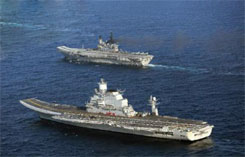 Guarding the south-east oceanic routes is paramount
Guarding the south-east oceanic routes is paramount
THE INDIAN Ocean was a region of extreme significance for the British economy and the strategic integrity of the “empire”. In the Indian oceanic system, the determination of the segment lying between the Straits of Hormuz and Straits of Malacca as a zone of strategic concerns for the Indian state goes back to the period of the colonial rule of two centuries. But in independent India, the enunciation of this thought truly fructified with the cessation of the Cold War and the subsequent adoption of the market forces economy by the Indian state. The Nehruvian principle of the Indian Ocean as a Zone of Peace (IOZP) had recognised the value in the unhindered trade and freedom of the seas through the sea lanes of communication (SLOCs) as imperative for India’s security concerns. At heart of the matter was keeping the ocean free from power rivalries and acts of piracy on the seas.
A Role in the security of the Straits of Malacca and Singapore: The Security of navigation in the Straits of Malacca and Singapore needed to be viewed in two separate facets. The immediate and the prevalent threat had emerged from growing acts of maritime terrorism and piracy. Contrary to an assessment that the incidents had declined after the tsunami, the surge of violence that erupted since the end of February 2005, seemed to reach its peak in 2009. There were obvious ramifications; one of them being the classification of the straits as a war-risk zone in June 2005, by the Lloyd’s Market Association, and the subsequent enhancing of shipping insurance.
The inability to tackle the problem was essentially being ascribed to the inadequacy of the littorals’ security and law enforcement mechanism. They were being recognized as “armed robberies against ships” under the prevalent law, and only concerned coastal states could exercise jurisdiction. Indonesia and Malaysia were seen to be driven by this logic in opposing any external involvement in the straits, largely in the face of the then US-sponsored Regional Maritime Security Initiative (RMSI). These countries had invoked the principle of sovereignty in rejecting the initiative, although underlying the decision may have been a perception that the US may focus on terrorist issues only at the cost of other maritime crimes. And in a largely Muslim-inhabited region, the American rigid conceptions about Islam could have led to several undesirable and awkward situations for regimes, especially in Indonesia and Malaysia.
It was in the backdrop of these and other international pressures that MALSINDO (formed between Malaysia, Indonesia and Singapore) came into being in July 2004. It was formed to operationally tackle such attacks, whilst working in a coordinated manner in which patrolling ships were to follow a system of handing over when approaching the limits of a country’s jurisdiction. To an extent, it was not a joint mechanism —a system considered ideal for such a venture. The misgivings about the effectiveness of the mechanism remained, since the attacks continued unabated. India had offered security assistance as an equally affected neighbour monitoring the adjacent six degrees channel. There was a precedence in Indian Naval offshore patrol vessels (OPVs) having successfully escorted US high-value vessels through the straits in 2002. This useful Indian presence was noted and the ships of Indian and Indonesian navies had jointly patrolled the waters.
The second facet that accentuated India’s interest in joining the participative security mechanism for the straits was an amalgam of far more important strategic security concerns; the aspect of energy security for the India. It was also because several crude import sources in Russia (Sakhalin), Vietnam and Indonesia had been added to augment the supply zones for India and elsewhere in the world. The safety and security of eastern sea lines and the straits of south-east Asia had, thus, jumped up in the ladder of importance, linked with India’s galloping trade with China, Japan, South Korea and the Asean countries.
The Andaman and Nicobar Command: The islands of Andaman and Nicobar have always been of strategic value to Indian policy planners, although a clear demonstration of intent manifested only in the 1990s. The Chinese communication facility on the Cocos Island was the precursor.
(Incidentally, it may have come up where the colonial “Wireless and cable” listening post was located.) Development of the Chittagong Harbour in Bangladesh and construction of naval bases, radar and electronic intelligence stations and airstrips along the entire Myanmar coast were the ominous developments to follow. The Haingyi naval base was reportedly designed to host Chinese submarines, should Myanmar’s regime acquiesce to a request. The proposed 800- mile Irrawady river road link was planned to join the Yunan province in China, to the Bay of Bengal.
India has been witnessing a substantial increase in what is termed as “nontraditional threats to security”, which manifest in spheres of drugs and gun running, illicit migration to the islands and, to some extent, deficiencies in what the mariners call good order at sea. It was also necessary to have a mechanism in place to prevent an unhindered passage to undesirable elements from terrorist groups linking up with similar groups in India. India has a formidable problem of armed militancy and India and Sri Lanka have, in the past, agreed to jointly patrol the Palk Straits, north of Sri Lanka. In conjunction, perhaps, the spectre of concerns which manifested in the early 1990s as a sequel to claims of the Peoples Republic of China (PRC) on the Spratlys and Paracel Islands of the South China Sea had irked the policymakers in New Delhi. The sinking of the Vietnamese Naval vessel by a Chinese Naval Ship was seen to be heightening tensions in the region.
